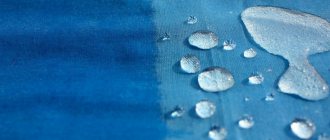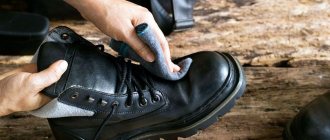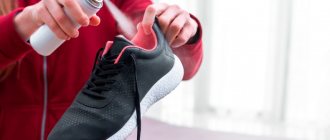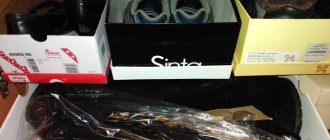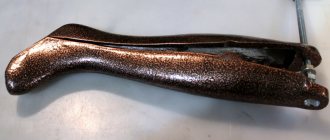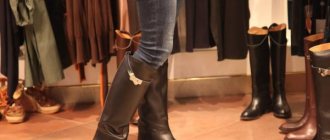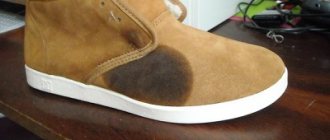For shoes to last longer, they need proper care. This is especially true during the winter season, autumn and spring, when frequent rains and slush spoil not only your mood, but also your favorite pair of shoes. To avoid such consequences and extend the life of the product, there is a special water-repellent impregnation for shoes.
Don't skimp on water-repellent sprays. The durability and integrity of the boots directly depends on this. You'll spend a little over ten percent of the cost of a pair on these items, but you can save a lot more when purchasing new shoes.
To choose the right product, you need to understand how to use water-repellent shoe spray and which impregnation is better.
Why do you need special shoe treatment?
Shoes must be protected from adverse factors. Otherwise, it will quickly deteriorate. Water repellent for shoes can create a special protective surface that resists moisture and dirt.
When liquid or dirt gets on your boots or other product, unfavorable processes begin that negatively affect the strength and durability of the shoes:
- The reliability and strength of the product decreases. It becomes soft and is exposed to negative influences from the outside. For this reason, the skin begins to crack, loses its natural shine, and becomes vulnerable to physical damage.
- Hydrophobic impregnation for shoes is especially required in the cold season. This is due to the fact that severe frosts destroy the protective properties of products, which increases the likelihood of rupture or destruction of the protective layer.
- Water creates a film on the surface. In turn, this blocks the air absorption properties of the protective membrane. As a result, the shoes are not saturated with the required amount of useful substances, which destroys the natural structure of the fabric.
- Without treating shoes from water and dirt, the leather becomes less elastic, loses all its properties, cracks faster and becomes unusable.
If you do not use impregnation for shoes, they will quickly deteriorate and lose their attractive appearance. Therefore, it is recommended to definitely purchase a product for the season that will help cope with humidity, dirt and other unfavorable factors.
What happens to shoes when they get water:
- The strength
of most materials when wet
is lower
than when dry.
Leather
and textiles
faster
. - At low temperatures, water in the product expands, which leads to rupture of the fabric or protective membrane.
- Water forms a film, the membrane will stop breathing
- the vapors have nowhere to go. - After drying, the skin loses its elasticity
, becomes stiff, and
cracks
.
And what can we say about aesthetics when dirt and reagents get on shoes:
Reagents inside the leather continue to destroy shoes if neutralizing agents are not used promptly. Protect your shoes and yourself from getting wet and hypothermia
Special water-repellent impregnations will help.
What should I use as a treatment?
There are many different impregnations for shoes. Each of them is sold in different packages and differs in structure. The most popular options are:
- Shoe cream. Depending on the consistency, there may be liquid or thick structures. Made from natural fats, dyes and other materials. Designed exclusively for leather models. Other types of shoes will be damaged. Does not contain any solvents. For this reason, it does not help to completely protect the surface from possible damage. Most often used as a regular shoe polish to add natural shine and beauty to leather.
- Shoe spray is water-repellent. Designed for almost any type of materials used. Can also be used to process clothing. It is multifunctional. They are characterized by a long service life and excellent protective properties, which allows them to expand their scope of application.
- Impregnation for leather shoes. They penetrate deeply into the structure of the coating, which allows you to protect the product for a long time from the effects of adverse natural phenomena. Each type of fabric or leather has its own type of solution. It is not recommended to use a product that is not intended for this type of material. In specialized stores you can find what you need. Read the instructions and ingredients on the package carefully.
It is recommended to use a shoe spray to remove dirt and water. This is a more universal tool that does not depend on materials.
Folk remedies for impregnating the skin
There are many ways to make your own shoe impregnation. Let's look at some of them.
Recipe 1
One of the most popular recipes is a mixture of equal parts flax and lamb fat. To ensure the ingredients combine well:
- the mixture is heated in a water bath and mixed thoroughly;
- sometimes a little turpentine or paraffin is added.
Important! You can apply the product with a flannel or woolen cloth.
Recipe 2:
- Add 200 g of drying oil and 100 g of rubber glue to heated paraffin (50 grams).
- The mass should be warm, so it is best to put the mixture in a steam bath.
- Add 100 g of castor oil and turpentine to the warm mixture.
- All ingredients must be thoroughly mixed and the finished mixture soaked not only the top of the boots, but also the sole.
Important! Shoes need to be dried for several days. But then your favorite boots will be waterproof for a long time.
Recipe 3
- Mix wax and linseed oil in a ratio of 3 to 1, place in a water bath and heat until the wax is completely dissolved.
- Apply the warm mixture to the skin and rub in with a flannel cloth.
Recipe 4
Another simple proven method:-
- Take a wax candle and rub it over the entire surface of the shoe.
Important! It is better to take a candle without dyes, glitter, etc.
- Then turn on the hair dryer at maximum power and blow it on your shoes or boots.
- The wax will melt under the influence of hot air and be absorbed into the surface of the skin. Then you need to take a strip of soft cloth and rub your boots with it.
Important! For a better effect, you can apply two or three layers of wax.
Recipe 5
This recipe is suitable not only for leather, but also for other surfaces, for example, wood:
- We take beeswax, natural linseed oil and turpentine.
- Grate the wax and melt it in a water bath, after complete dissolution, remove it from the heat and pour in the drying oil.
- You can simply mix wax and drying oil in a 1 to 1 ratio, or you can add turpentine. Then we will need 2 parts wax, one part drying oil and one part turpentine.
- After the mixture has cooled, you can rub it into the skin.
Important! This water-repellent impregnation for shoes with your own hands, if without turpentine, is very dense and does not melt in your hands. And the mixture with turpentine has a paste-like consistency: if you take a little of the impregnation in your hand, it slowly begins to melt, spreading the smell of resin.
Recipe 6
When hiking, it is very important that your shoes do not slip, breathe well, and do not get wet for a long time. Wet shoes lead to blisters and cause freezing of the feet. The next method is more suitable not for city shoes, but specifically for hiking boots.
The following product is great for leather hiking boots:
- Prepare: castor oil - 120 g, linseed oil - 12 g, turpentine - 12 g, wax - 12 g.
Important! Castor and linseed oil can be easily purchased at any pharmacy, turpentine - in the hardware or construction department. Well, you can buy wax either from beekeepers or in special stores. This DIY shoe impregnation will cost you little, but it will last for a long time.
- Mix all the ingredients, put them in a steam bath, heat until the wax melts completely.
This mixture should be applied when heated to warm shoes. That is:
- Before each use, it must be heated in a water bath.
- The boots can be heated with a hairdryer or simply held near a heat source. Just don’t bring it too close, so that the metal parts of the boots, if any, do not melt.
- Warm the leather material evenly before application, and then apply a thick layer to all leather areas of the boots, as well as the seam joints and the sole with the last. Warm impregnation flows, fills small holes, and when it hardens, it hardens and clogs them.
- It is recommended to apply it in two or three layers.
Important! This product is not suitable for city shoes, since after impregnation the shoes darken.
Impregnation operating principle
Each surface is characterized by special properties:
- Hydrophilicity. The liquid spreads over the entire surface and gets into all corners of the product.
- Hydrophobicity. Water is not absorbed, but collects in small drops on the surface.
A water-repellent spray for suede, leather and other types of natural materials must be used. These materials are classified as hydrophilic. At the same time, there are small pores on the surface of these materials, the ingress of water into which can damage the entire shoe.
You should not choose cheap products, as they create a film that does not allow your feet to breathe. It is better to opt for a hydrophobic product that forms a safe protective shell. Their cost varies from fifty to three thousand rubles.
Treating new boots before first use
Let the boots be nubuck (to be specific).
The purpose of the first treatment is to fill the pores in the material and make it water-repellent (this impregnation is called impregnation). Get the effect of smooth skin.
- Buy leather impregnation, for example, water-based - Nikwax Conditioner for Leather. You will also need a brush (preferably large enough) with natural bristles to rub in the impregnation.
- Wet the nubuck a little with water so that the lining inside becomes cool, but not damp. The leather top and inserts do not need to be wetted; they will not be coated with impregnation. Water is needed so that the impregnation adheres better to the material.
- Apply impregnation to the nubuck parts until a uniform white coating appears. Pay special attention to the seams, the junctions of individual pieces of material and near the sole and rubber at the front. After it has absorbed a little, coat it again, especially the seams and previously poorly coated areas (they stand out because their color has not changed). Some club members recommend repeating this procedure more than twice, with an interval of a day, so that more liquid can be introduced into the material (after absorption in previous visits). It is believed that repeating the procedure more than twice should lead to better impregnation of the boots.
- Take a brush with soft natural bristles and rub the impregnation for a long time until you get the effect of smooth skin. The surface should become shiny. (You can rub in 2 passes, allowing the composition to completely absorb into the nubuck in between passes.)
After this, the boots are ready for use.
Advantages and disadvantages of impregnation
High-quality water-repellent products for suede shoes are characterized by the following advantages:
- high efficiency and practicality;
- lightness, since their composition does not weigh down the shoes themselves;
- protect the surface from water ingress;
- make the skin more elastic and resistant to damage;
- convenient to use.
Some water-repellent shoe products have the following disadvantages:
- impregnation must be applied to the surface constantly;
- follow the manufacturer's instructions and do not violate the rules of use;
- some formulations have a specific odor, so it is recommended to carry out processing in well-ventilated areas;
- It is better to use specific products that are designed for a specific material.
How should you apply impregnation to suede shoes?
Before applying impregnation, make sure that the suede is well cleaned . The water-repellent agent should be sprayed at a distance of at least 30 cm from a pair of shoes. The room should be well ventilated.
It is important not to inhale the product when spraying. And also take care to cover the floor or area where the shoe is, since the spray can color the surface nearby (if it combines the properties of 2 in 1, where tone coloring is added to the protection).
Important! New boots are treated three times, and already worn ones should be treated with the product immediately after cleaning them once.
When purchasing suede shoes, you should immediately buy care products. You can consult with a specialist at a shoe store or buy the product at your own discretion. The main thing is to apply them constantly and in a timely manner.
How long to wear compression stockings after surgery?
Skirt patterns for obese women
How to use?
First you need to study what water-repellent impregnation for clothes or shoes is intended for. Different materials will require different products. If you have many different models, choose universal sprays.
Choose a consistency that is convenient for you. The most convenient option is a spray. It allows you to quickly apply the composition, which allows it to soak in. At the same time, consumption goes faster than in creams or impregnations. Buy products only from trusted manufacturers.
Step-by-step instruction
Below we will look at how to use water-repellent shoe spray:
- Rinse and dry your shoes thoroughly.
- For suede, use a special brush and steam treatment of the surface in greasy areas.
- Excess moisture can be removed with newspaper or dry paper tissues.
- Use a water-repellent treatment for suede or other materials. Follow the instructions. Apply the solution in a thin layer and thoroughly treat the entire surface.
- For sensitive materials, a repeat procedure will be required.
- There is no need to use several means at the same time, since their actions are mutually exclusive.
Treatment with a water-repellent suede spray should occur several hours before leaving the house. It's best to do this at night.
Traditional cleaning methods
Starch
This option is suitable for snow-white suede pile. It is necessary to sprinkle the surface with starch, and then remove the remaining powder with a special brush. This dry cleaning will preserve the color of your pair.
Starch also removes greasy stains well. You should sprinkle it on the dirt and leave it for 30 minutes, then clean the product off the suede.
Tip : to maintain the softness and shine of light leather shoes, once a week you can wipe them with a cotton pad soaked in sour cream or milk.
Onion
Onion juice is a wonderful remedy for fighting stains. Just apply a couple of drops to the stain, wipe with a damp cloth, and your boots will look like new. True, this method has a drawback - the specific smell of the vegetable persists for several days.
Baking soda
Cleaning with soda is perfect for white leather shoes. You will need to dissolve a tablespoon of powder in 200 ml of water, dip a soft cloth in the mixture and clean the surface with it. This product can remove fresh stains from shoes made of any material.
Tip : dissolve baking soda in warm water and mix the ingredients thoroughly so that no grains remain. If they get on a leather product, they can form microcracks during friction.
Vinegar
This product perfectly removes salt stains from leather shoes. You will need to dissolve 2 tsp. spoons of vinegar in 1 tbsp. l. water, mix. Wipe the surface with a cotton pad soaked in the mixture, remove excess liquid with a rag. Allow the products to dry at room temperature and then apply cream.
How to care for different types of shoes?
Different materials have different properties and require appropriate care. The most popular options are described below.
Patent leather shoes
The material is very sensitive to rough influence, so you need to use cotton wool or a cotton pad to carefully use the special product. To learn how to apply water-repellent impregnation for clothing, it is recommended that you read the instructions on the package. Try to wear patent leather shoes less in rainy weather so as not to spoil the shiny coating.
Suede
These shoes require careful care. Special brushes and soft products are used for cleaning. Problems especially arise in the off-season and winter. Water-repellent suede spray should only be applied to dry and clean shoes. Do not store it in bags as mold may form.
Genuine Leather
Leather shoes should only be treated with special creams to avoid damage to the surface. It is recommended to apply the product in a thin layer so as not to damage the structure of the shoe.
Release forms
The stores offer a wide selection of hydrophobic impregnations for shoes. Manufacturers claim that their products are equally effective regardless of the form of release. But in order not to spoil your shoes, you need to find out everything about the composition of such products.
Impregnations protect leather, suede and other materials from moisture. However, you need to take into account that if the shoes are of poor quality, then not a single remedy will help it.
Thick creams are great for leather products. They are very popular not only because of their good waterproof properties, but also because they extend the life of the product by restoring the structure of the material (giving additional elasticity and softness to the surface). Mink oil, which is part of creams, is an excellent natural remedy for moisture protection.
When using, the product must be applied in an even thin layer to the cleaned leather surface and left until completely absorbed.
On store shelves you can find liquid creams and emulsions . But you shouldn’t count on complete protection from moisture when using them. Manufacturers often add water to their products, which adds shine, but nothing more.
Water repellent sprays
These products are very easy to use, which is why they are popular among consumers. During use, a water-repellent spray is sprayed over a previously cleaned surface, after which the product is allowed to dry. There is no need to buy additional brushes, sponges, etc. In addition, the shelf life is very attractive - if you buy one bottle of spray, you can use it for several years.
Such products may contain seal fat (softens the skin), pigments of different colors (color the product), etc. That is why the spray is used not only for treating shoes, but also for clothes, bags and other leather products.
It is better not to treat shoes indoors, but a balcony is ideal for this purpose.
Hydrophobic agents
The main difference between impregnation and other means is that it penetrates deep into the fibers of the material. This helps create additional protection from getting wet.
For each type of material it is necessary to select the correct impregnation.
Its composition should include:
- fluorocarbon resin, if you need to treat shoes made of material with fibers (suede or nubuck);
- silicone when it comes to leather and other smooth surfaces;
- water repellent, if the textile product requires additional care.
Silicone impregnations are very popular. 8-9 hours after treatment, a silicone film remains on the surface. Water that gets on the shoes drains from them without having time to be absorbed. But this film does not allow the product to breathe.
Fluorocarbon resin has a different operating principle: small particles of impregnation, distributed between the fibers of the material being processed, maintain normal air exchange. As a result, water droplets do not penetrate inside, but simply remain on the surface.
Hydrophobic agents are used to treat textile products. They leave an invisible film on the surface between the fibers of the material. The hydrophobic effect significantly reduces the likelihood of liquid penetration, so drops do not get inside. Such impregnations do not contain wax, fat, silicone or other substances that can spoil textile products.
Water-repellent impregnations produced specifically for smooth leather cannot be used for suede shoes. Such products contain wax and fat, which glue the villi and spoil the suede product.
Before purchasing, you need to thoroughly study the composition of the impregnation. If it contains the inscription “water-repellent component,” then it is better to refuse the purchase. Manufacturers of quality products indicate the exact names of all components.
The best manufacturers of water-repellent impregnations
Among the best water-repellent impregnations and sprays for suede, the following should be noted:
- Collonil. An inexpensive product that is accessible to everyone. It is characterized by versatility, as it can be used for different materials. Covers the surface with a thin protective layer, which allows protection from adverse external influences. More suitable for use in the off-season.
- Salamander. Spray for nubuck and other materials. The optimum ratio of price and quality. Can be used for different things. At the same time, it has a pungent odor, so it is better to use it in an open space.
- Aqua booking. Spray for nubuck, which is sold in any market at an affordable price. It is characterized by versatility, as it can be used for clothing and objects. Does not contain harmful substances. Enough for several months of active use.
Listed above are the most popular manufacturers of water-repellent impregnations for shoes made of nubuck and other materials. Each of them is characterized by high quality. The only difference is the price.
Pros and cons of suede protectants
Products for protecting suede from precipitation and dirt have the following advantages:
- efficiency in caring for suede products (shoes do not dry out or warp);
- safety of the product for the human body;
- do not allow the material to fade (even when exposed to moisture, after such a spray the boots have their original tone);
- do not affect the breathability of the material.
Of the minuses:
- require strict adherence to instructions before use;
- processing time is required;
- when there is heavy rainfall, you have to buy more than one can of spray per season (some people consider this quite expensive, although the price is hardly 10% of the original cost of a pair of shoes).

